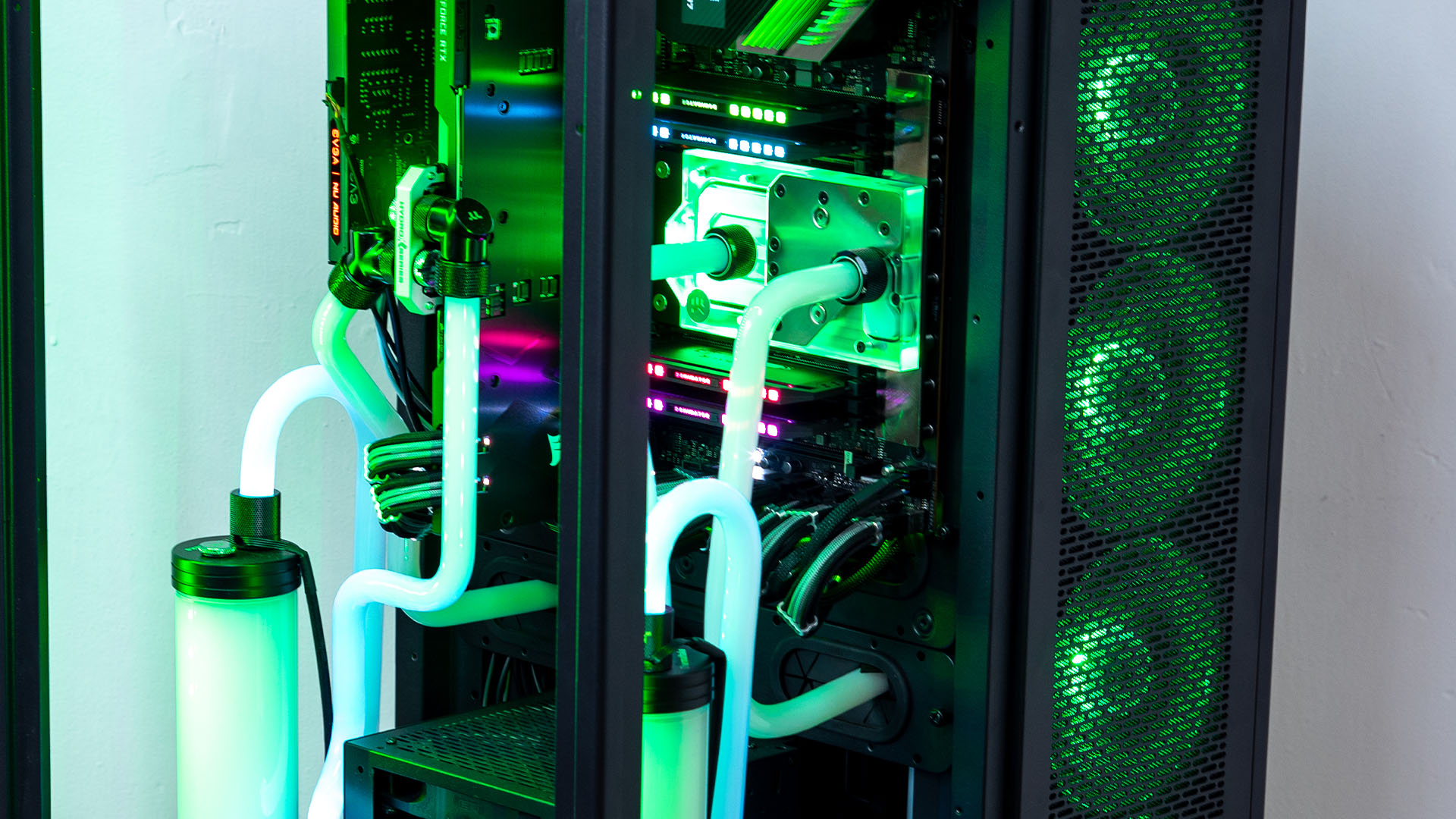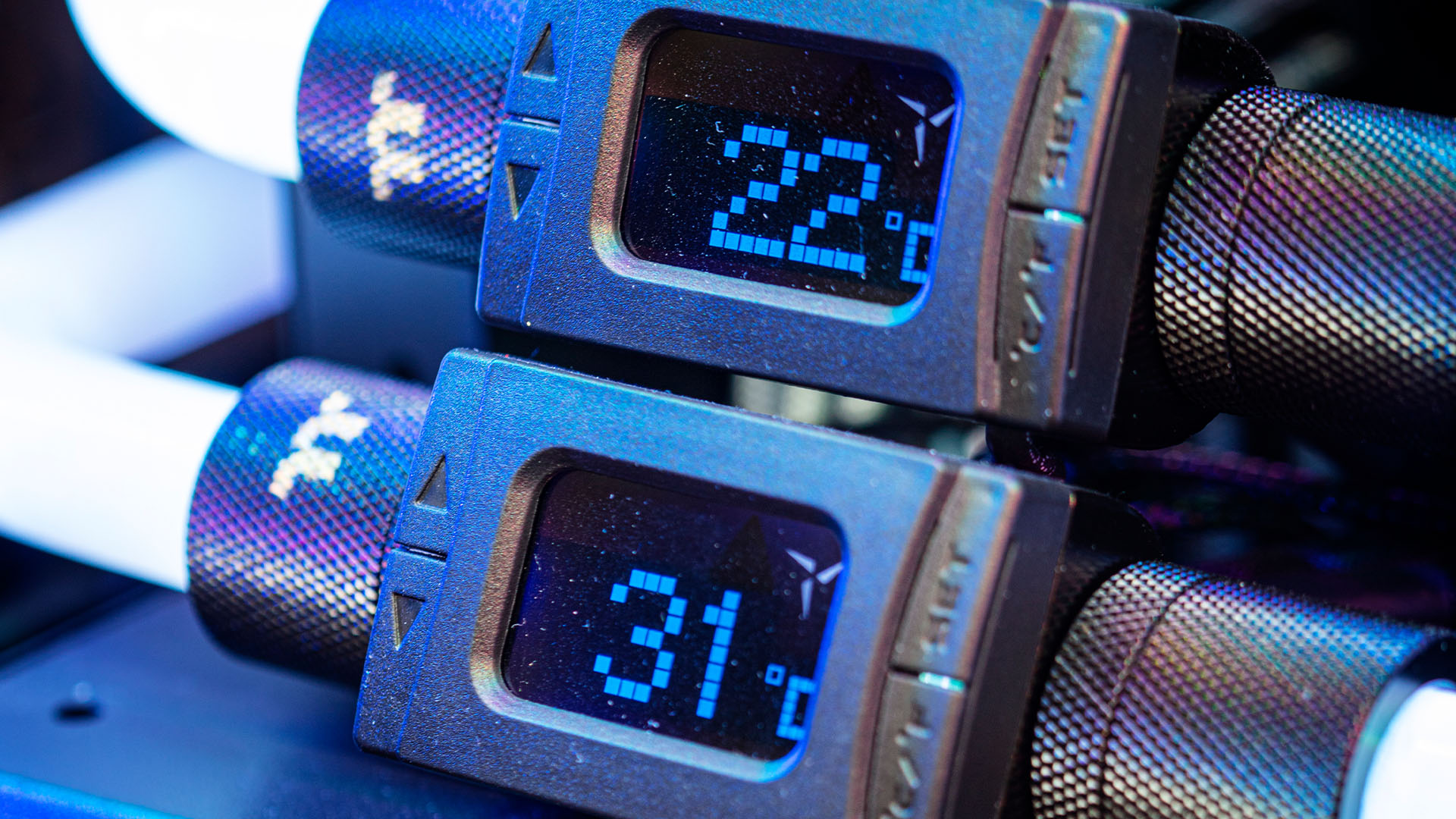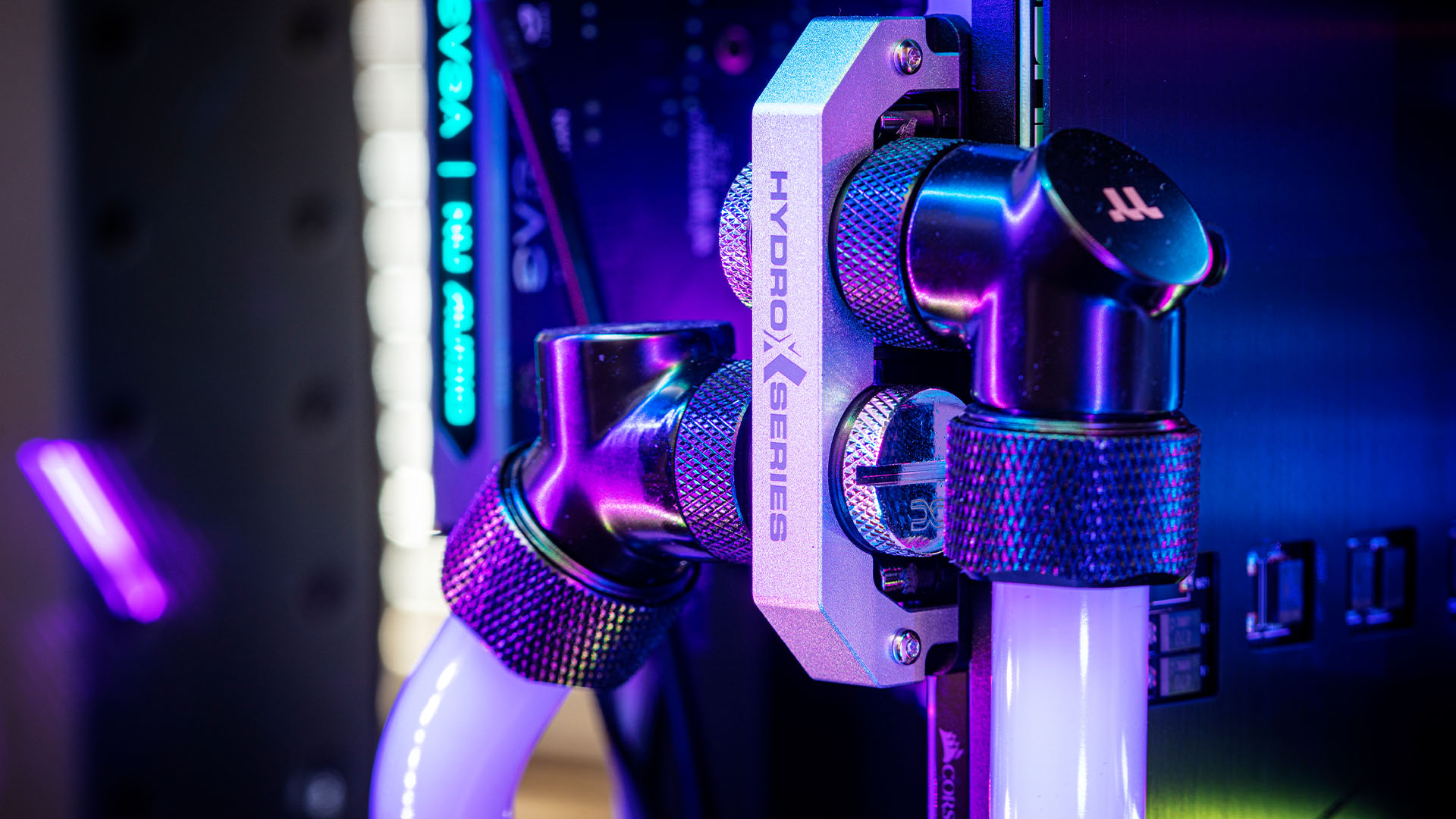In the event you assume a 360mm AIO liquid cooler has a great deal of cooling energy, then wait till you see the monstrous cooling skills of this water-cooled Threadripper gaming PC construct. This monster Threadripper PC, which proprietor Sam Liggat calls The Silent Storm, options a great deal of freehand tubing bends throughout two loops, connected to 2 colossal 560mm radiators.
Due to our quickly rising PC constructing Fb web page, we’ve seen many customized gaming PCs, from mods based mostly on present case designs to scratch PC builds. You may even submit yours for consideration proper right here. Now let’s chat to Sam about how he made this tough tube water-cooled PC construct.
: What impressed you to construct this PC, and why did you select to construct it within the Thermaltake Tower 900 chassis?
Sam: It began after I ran out of quick storage on my previous rig. We’ve got a painfully gradual web connection at my workshop, so I discovered myself having to delete previous packages and video games every time I needed to set up one thing new. I picked up an Asus PCIe NVMe growth card, however my previous motherboard didn’t assist lane bifurcation, so just one drive was accessible.
I’d been feeling the itch to construct a brand new PC for some time anyway, so this was the proper excuse. The Threadripper was the perfect alternative, because of the colossal variety of PCIe lanes, permitting me to run a number of NVMe drives alongside a quick graphics card, EVGA sound card, and Vive wi-fi card.
In all honesty, the CPU isn’t used to its full capability. I do some video transcoding for YouTube and a good bit of CAD modeling for 3D printing, however more often than not solely 4 or 5 cores are in use. The true profit comes from all these PCIe lanes.
As soon as I’d settled on Threadripper, I knew that noise was going to be the largest concern. I like quiet PCs, however I’m not prepared to sacrifice efficiency for low-noise operation – there needed to be a approach to obtain each.
This led on to the motherboard alternative, as the extra energy dealing with permits it to run a lot cooler than different choices, and the selection to make use of huge 560mm radiators with the Thermaltake Tower 900 case – it was the one case that would deal with a number of 560mm rads as commonplace.
These tight bends and turns within the tubing appear like a whole lot of work – why did you select to go along with this methodology moderately than utilizing angled fittings and straight tubing?
I took my inspiration there from the prevailing builds I’d seen in Tower 900 circumstances. I actually preferred among the designs, however I believed a extra complicated, fluid-pipe setup would distinction effectively with the robust, easy geometric form of the case. I work with miniature gearboxes for airsoft weapons every single day, which will be very fiddly and irritating, so I felt I used to be up for the problem.
How did you go about measuring, chopping and bending the tubing?
This was my first hardline water-cooling loop. To keep away from pointless frustration and decrease compatibility points, I attempted to stay with one model as a lot as attainable. I went with Thermaltake PETG 16mm tubing, and used the Thermaltake tube-cutting device equipment for many of the tube work. I measured utilizing paracord and a tape measure, and I additionally mocked up every run after every bend.

That’s an infinite quantity of cooling energy. Why did you employ two loops with 560mm radiators?
Ha, yeah, it turned out to be much more complicated than I initially imagined! I selected the 560mm radiators, so I might use ultra-quiet followers however nonetheless adequately cool the beastly processor. I then went for 2 loops, as I didn’t need the CPU to be dumping extra warmth into the GPU cooler, or the opposite means round.
The Bio-Loop PWM followers (all 13 of them) are barely audible when operating at 11 % velocity, however the system remains to be capable of preserve the CPU at 55°C or cooler below gentle load, and below 70°C below full load, whereas the graphics card has but to breach 46°C below full load. There’s loads of room for overclocking too. The CPU is presently operating at inventory velocity for probably the most half, however the graphics card has an extra 11 % overclock above the Asus Strix manufacturing facility overclock.
Separating the 2 loops additionally permits for simpler growth, so I can improve the graphics card when one thing new comes calling. The left loop is linked to the CPU/motherboard monoblock after which again to the right-side radiator. The correct loop cools the graphics card and is linked to the left-side radiator. Each loops cross on the entrance after which once more on the again.
I additionally knew I wished to have the 2 coolant temperature screens on the entrance, to occupy that lifeless house and conceal all of the cables contained in the central column, so the loop designs had been loosely deliberate round them.
How helpful are the temperature screens?
They’re positively not important – they had been extra of an aesthetic alternative, with the bonus of letting you simply monitor the coolant temps. They monitor the coolant because it leaves the reservoir and, at that time, even below full load when stress testing, the coolant temperature hardly ever exceeds 35°C.

The place did you get these PSU cables, and the way did you intend the cable routing?
The Asus motherboard got here with a 20 % off coupon for CableMod US, in order that’s the place I purchased the cables. The PSU comes with lengthy cables, however they weren’t lengthy sufficient for this case, so I knew I used to be at all times going to want longer ones. Cable routing is a responsible pleasure of mine, so it was fairly simple and there’s heaps of house to maintain them neat and in line. There are a number of hidden cable ties between among the bundles to maintain them in place.
How did you intend the lighting?
Lighting was a little bit of an afterthought by way of planning. Initially, I deliberate to maintain it quite simple, with just a few white lights right here and there, however my six-year-old daughter satisfied me in any other case.
I picked up some Asus aRGB strips and Thermaltake RGB fittings for the tubing, however I wasn’t positive the place they’d go till I began. The aRGB strips sit properly within the entrance inside edges of the case, and aren’t seen from most angles. The RGB fittings went wherever I might neatly disguise their energy cables.
Did you carry out any customized case modifications?
There weren’t many modifications required. I made a cutout within the motherboard tray, so I might run the rear-mounted NVMe drive with a heatsink. I minimize it out with a Foredom rotary device and completed it off with a hand file and a few silicon carbide lapping paper, utilizing with a lightweight silicon oil to forestall the grit from clogging.
Did you come throughout any difficulties?
The most important ache was mounting the followers and radiators on the mounts. The followers include their very own zero-vibration mounting equipment, however their screws weren’t thick sufficient to chew into the radiator threads. In the meantime, the screws that got here with the rads weren’t lengthy sufficient to undergo each side of the followers however had been too lengthy to undergo only one aspect. I ended up having to chop down and end 32 screws by hand simply to mount the followers and rads.
The opposite major issue was getting these coolant screens degree and spaced aside appropriately. They’re solely supported by the tubing – a freehand spiral that was probably the most complicated a part of the construct. With the intention to get them sitting (virtually) completely, I needed to mount all of the water-cooling gear in place with the assist rod absolutely contained in the tube, and warmth the tube in situ whereas holding it nonetheless because it cooled. I needed to do the identical with the tube going to the GPU – the suitable tube has 4 bends and the left one has 5.

Are you proud of the tip end result, or do you would like you’d carried out a few of it otherwise looking back?
I’m round 98% proud of this construct. It’s the dream machine I’ve fantasized about for years, however there are a few little imperfections. One or two of the bends aren’t fairly excellent, however I can right them after I subsequent drain the system.
I’ll construct in a few air-bleed ports as effectively – there are two air bubbles that I merely can’t flush out because of the complexity of the loops. The load of the system (virtually 50kg) precludes tilting it to work them out, however a few valves on the high will type that downside.
Silent Storm water-cooled PC specs
- CPU: AMD Threadripper 3960X
- Case: Thermaltake Tower 900
- Graphics card: Asus ROG Strix GeForce RTX 2080 Ti OC
- Storage: 1TB Corsair PCIe 4 SSD for OS; 2 x 1TB Samsung 970 Professional NVMe SSDs
- Reminiscence: 64GB Corsair Dominator Platinum RGB 3400MHz (tweaked for tighter timings)
- Motherboard: Asus Zenith II Excessive Alpha TRX40
- PSU: Corsair AX1600i Titanium
- Cooling: Twin customized water-cooling loop comprising: 2 x Thermaltake PR22-D5 Silent pump/reservoir combos, 2 x Thermaltake in-line temp screens, 3 x Thermaltake Pacific Professional 90-degree fittings, 1 x Thermaltake Professional 45-degree becoming, 20 x Thermaltake Pacific Professional compression fittings, EK-Quantum Momentum monoblock for Asus Zenith II Excessive Alpha motherboard, Corsair Hydro waterblock for Asus RTX 2080 Ti Strix with Thermal Grizzly thermal pads, 5m of Thermaltake PETG hardline tubing, 2 x EK-Coolstream 560mm radiators, 2 x EK 3-way fittings (modified to work with the Thermaltake Professional fittings), 2 x Thermaltake Professional ceramic drain ports, 4 liters of Thermaltake Pastel White coolant, 1 x Thermaltake RGB becoming equipment, 13 x Black Silence Noiseblocker eLoop aRGB PWM 140mm followers
We’re gobsmacked by the cooling energy on this machine Sam – it makes the typical 240mm AIO cooler in our greatest AIO cooler information look positively weedy. Nicely carried out on the bends in your hardline water-cooling tubing too – it appears to be like nice. In the event you’re new to the world of water-cooling and need to have go your self, then be sure to additionally learn our full information on how one can water-cool your PC.
This publish initially appeared on Customized PC, which has been masking wonderful setups for over 20 years and is now a part of . Be part of our 500k member Fb group to debate this construct.
In the event you contemplate your self to be an knowledgeable PC builder, you possibly can submit your individual customized PC construct to us immediately for an opportunity of being featured on sooner or later.

